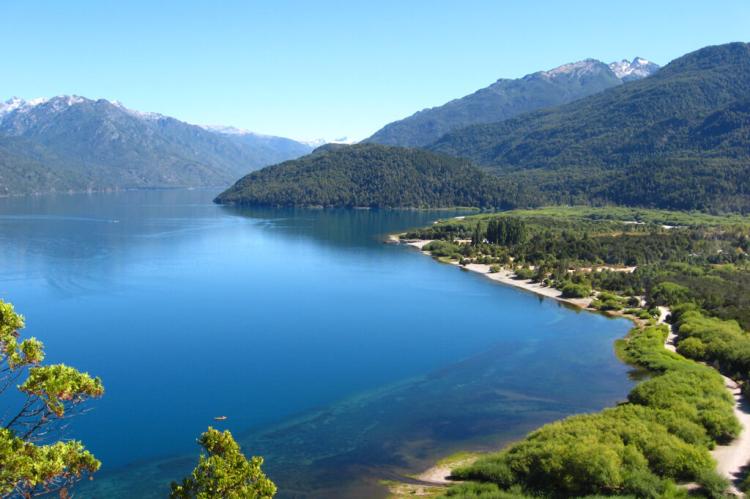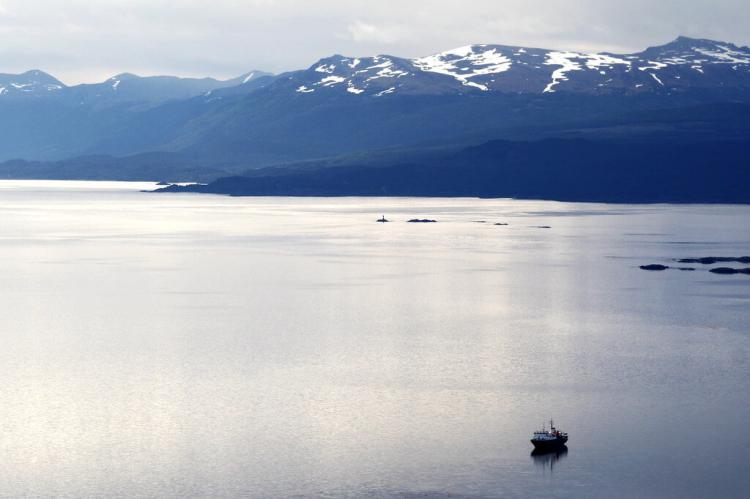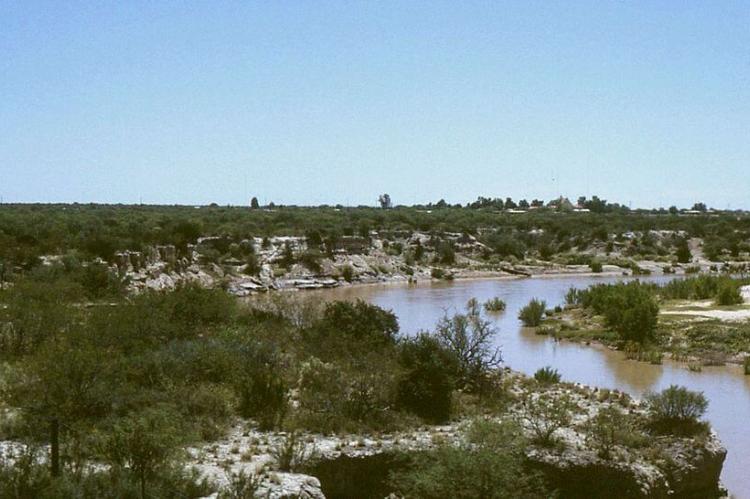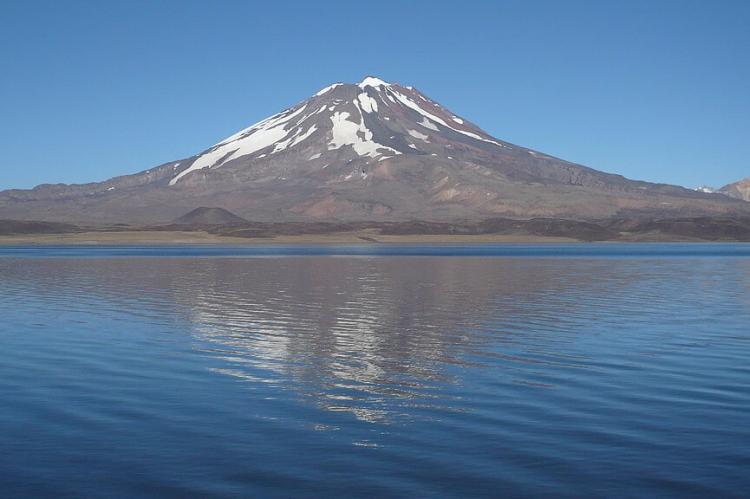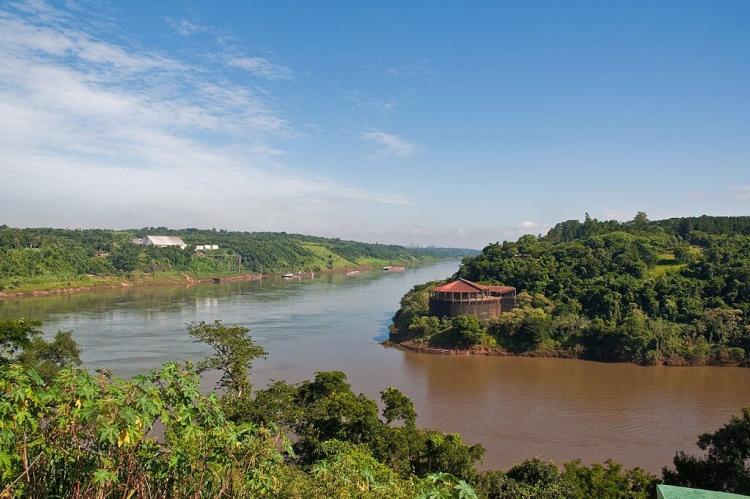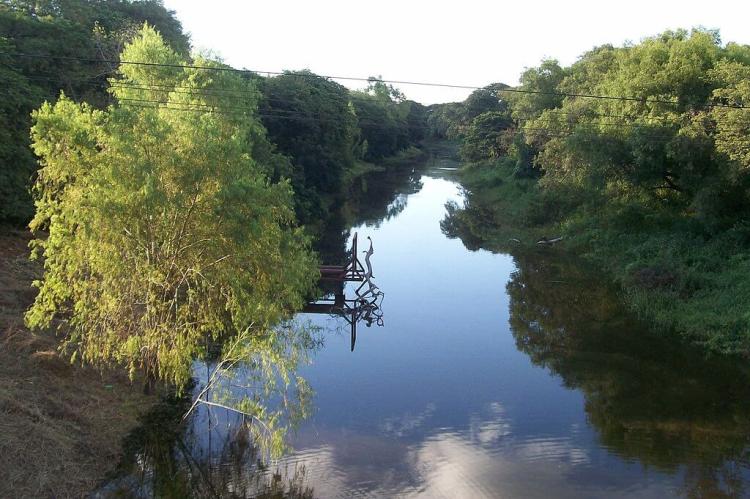Water Bodies of Argentina
Argentina has many water bodies across its vast terrain, including extensive coastlines on the Atlantic Ocean. Whether seeking adventure or solace in nature, Argentina's aquatic landscapes present abundant opportunities to connect with the country's natural heritage.
Water Bodies of Argentina
Argentina boasts diverse water bodies across its expansive terrain, offering visitors a rich tapestry of natural wonders to discover. Situated along the eastern border, the Atlantic Ocean graces Argentina with extensive coastlines adorned by picturesque beaches, ideal for leisurely seaside activities.
The Paraná River and its tributaries, such as the Paraguay and Uruguay rivers, traverse the country, providing opportunities for river cruises and various water-based pursuits. These waterways serve as vital transportation routes and showcase Argentina's varied landscapes, ranging from lush forests to vast plains.
In the western regions, the Andes Mountains give rise to several pristine lakes, including Nahuel Huapi and Lake Argentino, renowned for their breathtaking scenery and recreational offerings. Visitors can indulge in boating, fishing, and hiking amidst the serene beauty of these mountain-fed lakes.
One of Argentina's most iconic natural attractions is the awe-inspiring Iguazu Falls, located on the border with Brazil. This remarkable network of waterfalls, surrounded by lush rainforests, captivates visitors with its sheer scale and beauty, making it a must-see destination for nature enthusiasts.
From the expansive coastline of the Atlantic Ocean to the tranquil lakes nestled in the Andes Mountains and the majestic spectacle of Iguazu Falls, Argentina's water bodies offer a diverse range of experiences for exploration and enjoyment. Whether seeking adventure or solace in nature, Argentina's aquatic landscapes present abundant opportunities to connect with the country's natural heritage.
Aquifers
Guaraní Aquifer System: The Guaraní Aquifer System (GAS) is a large natural underground groundwater reservoir and hydrogeological system. It is a transboundary aquifer spread across four South American countries: Argentina, Brazil, Paraguay, and Uruguay. The primary use of the aquifer is for drinking water supply, but there are also industrial, agricultural irrigation, and thermal tourism uses.
Gulfs and Bays
Argentine Sea: The Argentine Sea is in the South Atlantic Ocean off the southeastern coast of Argentina, extending approximately from Montevideo, Uruguay, southward to Tierra del Fuego. It is one of the world's largest seas, with a surface area of about 1,000,000 sq km (390,000 sq mi).
Bahia Buen Suceso: Bahía Buen Suceso is a small bay in Argentina's Tierra del Fuego province. It is located on the western shore of Le Maire Strait, which separates Tierra del Fuego and Isla de los Estados.
Beagle Channel: The Beagle Channel is a strait that separates the Tierra del Fuego archipelago from the mainland of South America. It is named after the HMS Beagle, which Charles Darwin commanded during his voyage around the world.
Blanca Bay: Blanca Bay is a bay of the Argentine Sea located in the transition between the Pampas and Patagonia. The inlet (an estuary) is located in the southwest of Buenos Aires province, in the center-east of Argentina. The city of Bahía Blanca takes its name from the bay.
Golfo Nuevo: Golfo Nuevo is a body of water formed by the Península Valdés and Punta Ninfas in Chubut province in Argentine Patagonia.
Río de la Plata: The Río de la Plata is a tapering intrusion of the Atlantic Ocean on the east coast of South America between Uruguay to the north and Argentina to the south. It empties into the Atlantic Ocean, forming a funnel-shaped indentation on the southeastern coastline of South America. It forms part of the border between Argentina and Uruguay. While some geographers regard it as a gulf or as a marginal sea of the Atlantic Ocean, and others consider it to be a river, it is usually held to be the estuary of the Paraná River and Uruguay River (as well as of the Paraguay River, which drains into the Paraná). To those who regard the Río de la Plata as a river, it is the widest in the world, with a total area of about 35,000 sq km (13,500 sq mi).
Samborombón Bay: Samborombón Bay is located on the coast of the Argentine Sea near the southern end of the Río de la Plata estuary. The bay receives the Samborombón River from the northwest and the Salado River from the west.
San Jorge Gulf: The San Jorge Gulf is a bay in southern Patagonia, Argentina. It is an ocean basin opening to the Atlantic. Its shoreline spans Chubut and Santa Cruz provinces.
San Matías Gulf: The San Matías Gulf is an inlet of the Atlantic Ocean off the coast of Patagonia, Argentina. It is bordered to the south by the Valdés Peninsula.
San Sebastián Bay: San Sebastián Bay is located on the northern coast of Argentina's Tierra del Fuego Province.
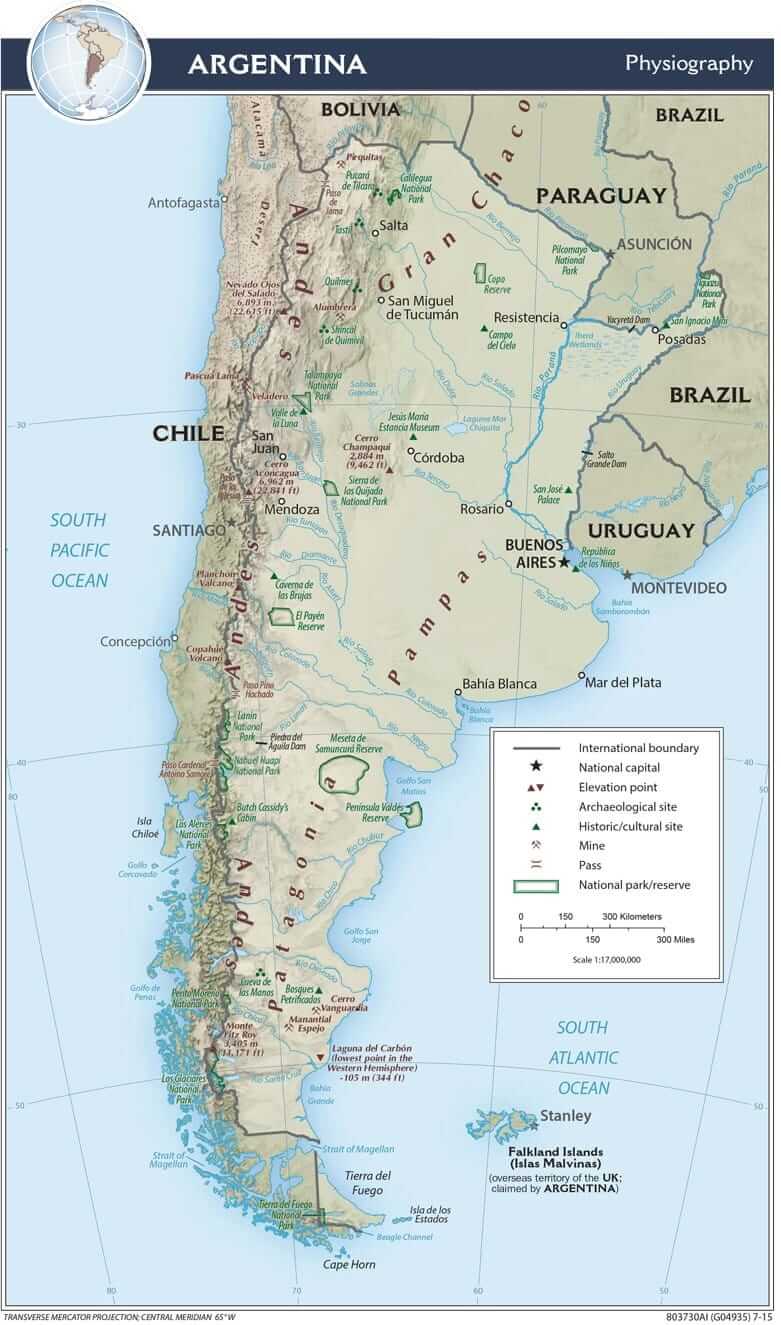
Argentina physiographic map.
Notable Dams and Reservoirs
Yacyretá Dam and Reservoir: Located on the Paraná River between Argentina and Paraguay, the Yacyretá Dam is one of Argentina's largest hydroelectric power plants. The reservoir created by the dam, known as the Yacyretá Reservoir, covers an area of about 1,600 sq km (617 sq mi) and provides significant electricity generation capacity for both Argentina and Paraguay.
Itaipu Dam and Reservoir: Although mainly situated in Brazil and Paraguay, the Itaipu Dam also extends into Argentina. It is a joint venture between the three countries and is considered one of the largest hydroelectric power plants in the world. The Itaipu Reservoir, created by the dam, spans a vast area and contributes to power generation and regional water management.
Embalse Nuclear Power Station and Reservoir: The Embalse Nuclear Power Station, located in the province of Córdoba, Argentina, is the country's only nuclear power plant. The reservoir formed by the Embalse Dam provides cooling water for the nuclear reactor and is also used for recreational purposes.
Los Molinos Dam and Reservoir: Situated in the province of Córdoba, the Los Molinos Dam is essential for water management and power generation in the region. The reservoir offers opportunities for water-based activities, such as boating and fishing, while the dam helps regulate water supply for agricultural and industrial purposes.
Pichi Picún Leufú Dam and Reservoir: Located in the Neuquén Province, the Pichi Picún Leufú Dam is an earth-fill dam that creates a reservoir used for hydroelectric power generation. The dam helps harness the energy potential of the river, providing electricity to the region.
El Nihuil Dam and Reservoir: Found in the Mendoza Province, the El Nihuil Dam is an important water resource management structure. The reservoir offers recreational activities such as swimming and fishing, and the dam assists in irrigation for agriculture in the arid region.
Potrerillos Dam and Reservoir: Also situated in the Mendoza Province, the Potrerillos Dam is another key water management system. The reservoir is utilized for recreational purposes and provides irrigation water to support local agriculture.
El Carrizal Dam and Reservoir: The El Carrizal Dam, located in Mendoza Province, is used for irrigation and contributes to the regional water supply. The reservoir offers opportunities for water sports and outdoor activities.
Notable Lakes and Lagoons
Lake Aluminé: Lake Aluminé is a large and deep lake located in the Andes in the western part of Neuquén Province, Argentina, near the border with Chile. The tourist town of Villa Pehuenia is on the lake's northern shore.
Laguna Blanca: The centerpiece of Laguna Blanca National Park is a serene lake amidst rolling hills and dense forests. Surrounding this centerpiece are rugged mountains, including the imposing Sierra de la Vaca Muerta.
Lake Buenos Aires (Lake General Carrera): Straddling the border between Argentina and Chile, Lake Buenos Aires is one of the largest glacial lakes in South America. Its Chilean portion is known as Lake General Carrera.
Lake Cami: Lake Cami, also known as Lake Fagnano, is located on the main island of the Tierra del Fuego Archipelago, which is shared by Argentina and Chile. The lake runs east-west for about 98 km (61 mi).
Lake Futalaufquen: Lake Futalaufquen is a large lake in Chubut, Argentina. Located in the Andes, Lake Futalaufquen is three-lobed, of glacial origin, and occupies narrow valleys between glaciated peaks. It is situated in Los Alerces National Park.
Lake Gutiérrez: Lake Gutiérrez is located in the lake region of northern Patagonia in Río Negro, Argentina. It is of glacial origin and is connected to Lake Nahuel Huapi.
Lake Huechulafquen: Lake Huechulafquen, in Neuquén Province, is a glacial Andean lake within Lanín National Park. It is one of Argentina's largest Andean lakes, fed by glaciers, meltwater streams, and lakes.
Laguna Brava: Laguna Brava is a salt lake lo the La Rioja Province of Argentina. It is the highest lake in Argentina, at an elevation of 4,300 m (14,100 ft).
Laguna del Diamante: Laguna del Diamante is a lake located in Mendoza, Argentina. Its surface area is approximately 14 sq km (5.4 sq mi), one of the most extensive freshwater resources in the province. Nearby is the Maipo volcano, which is on the border with Chile.
Lake Argentino: Lake Argentino is the largest freshwater lake in Argentina. It is located in Santa Cruz Province, within the Patagonia region of the country and is part of the Los Glaciares National Park.
Lake Buenos Aires: Lake Buenos Aires is the second-largest lake in Argentina and is shared with Chile. It is located on the Chile/Argentina border in the Patagonia region of the country. It is known as General Carrera Lake in Chile.
Mar Chiquita: Mar Chiquita is a saline lake located in the Province of Córdoba in central Argentina. It is fed primarily by the saline waters of the Dulce River. It is approximately 70 km (45 mi) wide and is the largest of the naturally occurring saline lakes in Argentina.
Lake Nahuel Huapi: Lake Nahuel Huapi is an Andean lake in the lake region of northern Patagonia between the Argentine provinces of Río Negro and Neuquén. The lake has a northwest-southeast elongated shape and complex geography with several branches, peninsulas, and islands. The city of Bariloche is on the lake's southern shore, and the town of Villa La Angostura lies on its northwestern shore. The lake is wholly inside Nahuel Huapi National Park.
Lake Puelo: Lake Puelo is located in the northern part of Chubut Province, in Argentine Patagonia, near the border with Chile. It is of fluvial-glacial origin, and its deepest point is 180 m (590 ft). Lago Puelo National Park surrounds the narrow L-shaped lake.
Lake San Roque: Lake San Roque is a reservoir in the Córdoba Province of Argentina. Argentina's largest artificial lake is used for hydroelectric power generation and irrigation.
Viedma Lake: Lake Viedma is a Patagonian lake in Santa Cruz, Argentina, near the border with Chile. It is an elongated trough lake approximately 80 km (50 mi) long, formed from melting glacial ice and is the second-largest perennial lake located entirely within Argentina.
Notable Rivers
Atuel River: The Atuel River is born in the Andes at 3,250 m (10,662 ft) in elevation from the glacial Atuel Lake. It primarily flows through Mendoza, with its last part in La Pampa. It is a significant source of water for irrigation in Argentina.
Bermejo River: The Bermejo River flows from Bolivia through Argentina, and it has different names along its length. It is a major tributary of the Paraguay River. Non-navigable, it is 1,060 km (660 mi) long and has a drainage basin of 123,000 sq km (47,000 sq mi).
Chubut River: The Chubut River flows eastwards for approximately 800 km (500 mi) from the Andes to the Atlantic Ocean through Argentina. Important for agriculture, it is the longest river in the Patagonia region of Argentina.
Colorado River: The Colorado River flows through Argentina and Chile. It marks most of the political boundary between the Argentine provinces of Neuquén and Mendoza and between Rio Negro and La Pampa. Its total length is about 1,000 km (620 mi), of which about 300 km (190 mi), from the coast up to Pichi Mahuida, are navigable.
Desaguadero River: The Desaguadero River originates in western Argentina near the Tipas volcano in the province of La Rioja at about 5,500 m (18,000 ft) elevation. The river is known in its upper reaches as the Bermejo or Vinchina. In its lower reaches, it is also known as the Salado. It joins the Colorado River in La Pampa Province near Pichi Mahuida. It has a total length of 1,498 km (931 mi), and its drainage basin is about 260,000 sq km (100,000 sq mi).
Iguazu River: The Iguazu River flows through Argentina and Brazil. It is best known for its Iguazu Falls, one of the world's largest waterfalls. In addition, it is an important tributary of the Paraná River. The Iguazu River is about 1,320 km (820 mi) long, and its drainage basin is approximately 62,000 sq km (24,000 sq mi).
Mendoza River: The Mendoza River flows through the province of Mendoza, Argentina. It is formed in the Andes between the Aconcagua and Tupungato massifs by the confluence of the Vacas, Cuevas and Tupungato rivers. It is a significant water source for irrigation and hydroelectric power generation in Argentina.
Negro River: The Negro River (Río Negro) is the main river of Patagonia in terms of the size of its drainage basin, its associated agricultural produce, and the population living on its shores. In eastern Patagonia, it is also the largest by flow rate. The river flows through the Argentine province of Río Negro, named after it.
Paraguay River: The Paraguay River is South America's fifth-largest river, running through Brazil, Paraguay, and Argentina. It serves as part of the border between Argentina and Paraguay. The river's total length is approximately 2,600 km (1,600 mi), from its headwaters south of Diamantino in the Brazilian state of Mato Grasso to its confluence with the Paraná River in Argentina, the main tributary.
Paraná River: The Paraná River is the second-longest river in South America, after the Amazon River. It runs through Brazil, Paraguay, and Argentina for 4,880 km (3,032 mi). Forming at the confluence of the Paranaiba and Rio Grande rivers in southern Brazil, it flows in a general southerly direction until it joins the Uruguay River to form the Río de la Plata on the border between Argentina and Uruguay. Its drainage basin, with an area of about 2,800,000 sq km (1,081,000 sq mi), includes the greater part of southeastern Brazil, Paraguay, southeastern Bolivia, and northern Argentina.
Pilcomayo River: The Pilcomayo River flows through Argentina, Bolivia, and Paraguay. At 1,100 km (680 mi), it is the longest western tributary of the Paraguay River. Its drainage basin is 270,000 sq km (100,000 sq mi). Along its course, the Pilcomayo silts up and splits into two main branches, North and South. After some distance, these branches rejoin to form the Lower Pilcomayo.
Río de la Plata: The Río de la Plata is a tapering intrusion of the Atlantic Ocean on the east coast of South America between Uruguay to the north and Argentina to the south. It empties into the Atlantic Ocean, forming a funnel-shaped indentation on the southeastern coastline of South America. It forms part of the border between Argentina and Uruguay. While some geographers regard it as a gulf or as a marginal sea of the Atlantic Ocean, and others consider it to be a river, it is usually held to be the estuary of the Paraná River and Uruguay River (as well as of the Paraguay River, which drains into the Paraná). To those who regard the Río de la Plata as a river, it is the widest in the world, with a total area of about 35,000 sq km (13,500 sq mi).
Salado River: The Salado River, one of the most polluted in Argentina, flows 1,150 km (710 mi) from its source in the Salta Province to where it merges with the Paraná River in Santa Fe Province. Because of its origin, its flow varies widely within the year, and it can dry out in some parts of its path during the winter. The only important tributary to the river is the Horcones River, which is born in Salta as the Cajón River and joins the Salado in the Santiago del Estero Province.
Santa Cruz River: The Santa Cruz River is a river in the Argentine province of Santa Cruz. It is of glacial origin and begins at the shores of the Viedma and Argentino lakes in Los Glaciares National Park. It runs 385 km (239 mi) eastwards before reaching the coast of the Atlantic Ocean, 350 km (217 mi) north of the southern tip of South America, creating a delta. It is one of the last large, free-flowing rivers in Patagonia.
Uruguay River: The Uruguay River is the second-longest river in Argentina, after the Paraná River. It flows through Argentina and Uruguay. Approximately 1,600 km (1,000 mi) in length, its headwaters originate in Brazil's coastal range. The river forms parts of the boundaries of Brazil, Uruguay, and Argentina before eventually joining the Río de la Plata.
